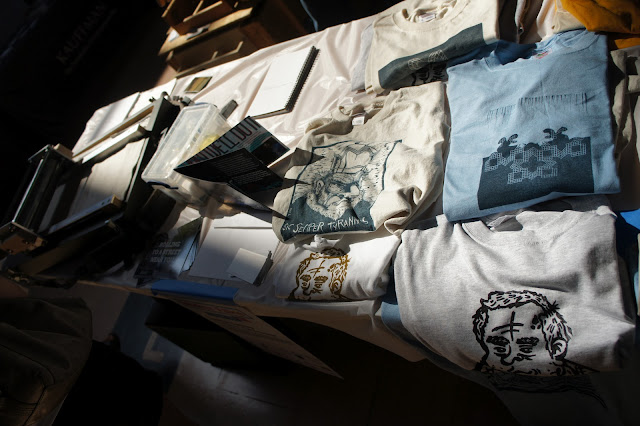Is this IBM Selectric II cool, or what? The maker grew bored with it and created a printer with the judicious use of programming, solenoids and cables. This maker collective, the Cowtown Computer Congress, had a bunch of projects on display and this was a big attention getter.
I assumed wrongly that the interface between the laptop and the typewriter was probably something Arduino. Nope. This guy etched his own circuit board!
Typewriter art, anyone? I could watch something like this for hours. Did you notice how much the ribbon cartridge and ball head look like a robot? Claire and I see robots everywhere.
To see this beast in action and a comprehensive build diary, visit http://www.robotdialogs.com/2012/06/typomatic-part-3.html The Cowtown Computer Congress is one of many hacker spaces that has emerged over the last few years. Makers share a space and major equipment with regular build nights and special events. A hacker space is a big playground for adults. Check around, there may be one in your town!
The Print Factory
My favorite entry in the traditional print department is the traveling crew from The Print Factory. They are printmaking evangelists and show up at regional events with great lino and woodcuts ready to ink and press. From experience, I can tell you this is just as enjoyable for adults as it is for kids.
Such pretty ink. To see more about The Print Factory, visit http://craftandconcept.com/
Maker Bot
Maker Faire would be pretty awesome without 3-D printers, but it wouldn't be the same. The Maker Bot crew was out in full force introducing people to the joys of home printing. The Maker Bot Replicator now has a dual extrusion print head... and a bunch of new competition. Their goal was to democratize the act of making and they spawned a new industry using true open source hardware and software. The competition is coming for around $600 as a home printer, but they may not be as dedicated to open source.
Other than the metal bits and servos, these remote control Minions came off a Maker Bot. The drawings, like everything else in Maker Bot world, are available on the Thingiverse.
Kids love watching Maker Bots in action as much as I do. It used to be that only elite schools and businesses had access to 3-D printing for prototyping and small run items. Not so long ago, the technology would have set you back over $10,000. The previous version of the Maker Bot ran around $1,400 and the new Replicator runs around $1,800.
One of the best things about 3-D printing: makers use them to build parts to make larger and more elaborate home brew printers. There were at least a dozen custom machines spread out around the Faire.
On the subject of democratizing 3-D printing, a number of libraries have installed Maker Bots. Imagine a future in which you could print any widget available on the Thingiverse or something you throw together on Google Sketchup with a library card and a few cents for materials. Do you need a replacement knob for a Hermes? Print on demand is cool.
Check out this set of wings produced by another member of the Cowtown Computer Congress. The gears were custom printed on a first generation machine.
Last year, the Kansas City Maker Faire filled this hall with some outside overflow. This year, they shut down a street in front of Union Station for the Arc Attack tent, Power Wheels, vendors, exhibitors and custom cars. That was in addition to three extra rooms inside the station. Sweet.
Thanks for reading! Part II will feature "Fun with Electricity".
A friendly reminder about the archaic concept of copyright: all photos are copyright Dwayne F. at vintagetechobsessions. Please cite the source if you liberate my images. They are not to be used for commercial purposes with or without citation. You could wake up with an Oliver 99 hovering over your bed. You have been warned.



















































